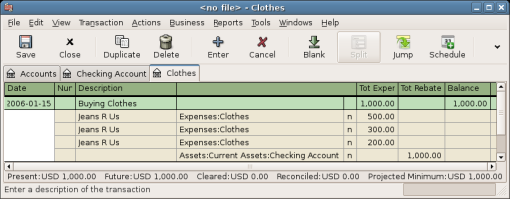GnuCash offers several options for viewing your registers. The
default style is Basic Ledger mode, which displays
only the summary of splits affecting the current account. This is the
style that most closely resembles other popular personal financial
packages.
You can choose a different register style by selecting → style expands the current transaction automatically. As you highlight a new transaction in the register, the transaction automatically expands to show all splits. The → style is more like an accounting journal, in which all splits are shown for all transactions.
All styles permit you to view your data in either single-line or double-line format. Select → , and you will see your transaction line expand to two register lines.
Let’s have a closer look at how the Basic Ledger and Transaction Journal view differs.
For this example, let’s assume that you have a checking account with $10,000, and have decided to really splurge by purchasing 3 pair of Jeans for $1,000. Now, you can either record this as one simple transaction and move $1,000 to Expenses:Clothes. Or, you can record a split transaction, and record each Jeans individually.
Technically they are the same, but from an accounting point of view, when you record each Jeans purchase separately, the Expenses:Clothes account will record three different transactions.
The below screenshots will illustrate this a bit better
First let’s purchase the Jeans from your checking account

This image shows one split transaction with 3 Jeans purchases
The we open the Expenses:Clothes account, and look at it from the default Basic Ledger view. As you can see, we have three entries here, but there were only one entry in the checking account. If you look carefully, you will see that each row have a different amount, $200, $300, and $500. Each row’s transaction line reflects a one split row.

This image shows Expenses:Clothes account in Basic Ledger mode.
If we view the Expenses:Clothes account in Transaction Journal mode, you will again, only see the original split transaction.

This image shows Expenses:Clothes account in Transaction Journal mode.